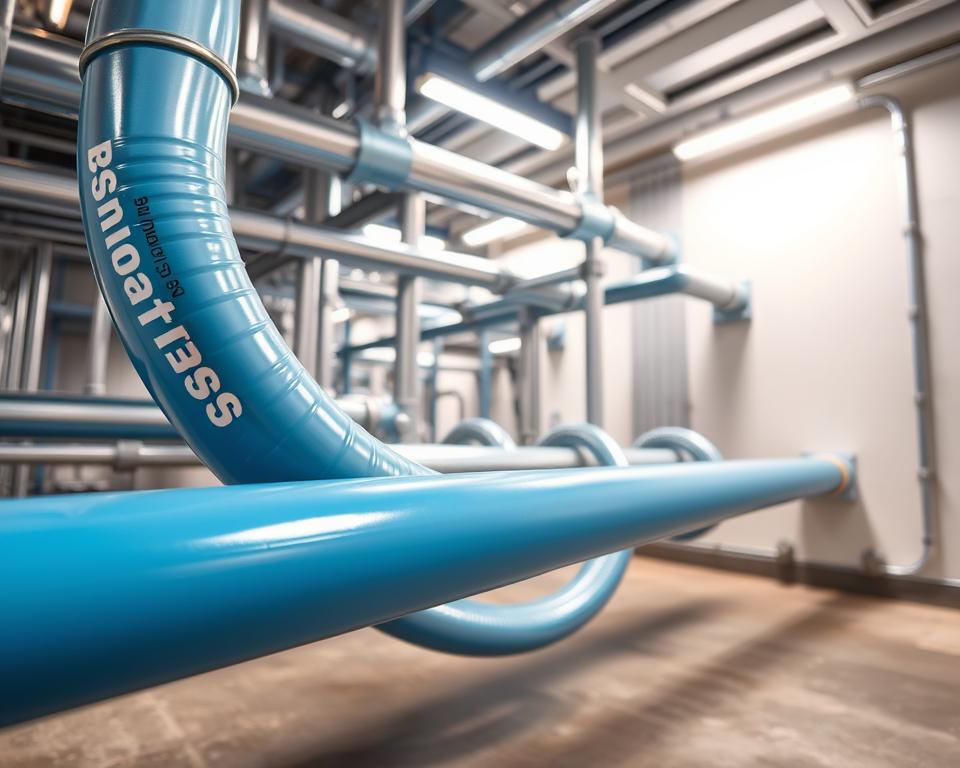PVC Pipe for Air Compressor Lines: Your Complete Guide
A burst compressed air line can discharge energy comparable to a stick of dynamite—did you know? Despite the hazards, numerous workshops continue installing piping systems from unsafe materials. Here’s why you must prioritize safety over cost when selecting PVC for air lines.
Despite growing interest in certain materials, OSHA strictly prohibits their use in above-ground applications. Over time, exposure to oils and temperature changes weakens them, leading to catastrophic failures. Safe-rated pressures can still result in deadly bursts.
For reliable alternatives, Installation Parts Supply offers durable solutions like aluminum. Using approved materials saves you from fines and enhances safety. Here’s how to assemble a risk-free system.

Key Takeaways
- OSHA bans certain materials due to explosion risks.
- Temperature changes can halve pressure ratings.
- Brittleness worsens over time, increasing failure risks.
- Aluminum piping offers a safer alternative.
- Invest wisely to dodge fines and protect staff.
Why PVC Pipe Is Dangerous for Compressed Air Systems
PVC makers caution never to employ it in high-pressure air setups. Unlike water, compressed air stores explosive energy—a ruptured line can release force comparable to dynamite. This makes material choice critical for safety.
- Brittleness: Sub-freezing temperatures turn materials brittle, increasing fracture risks.
- Adhesive failures: Oil contamination and heat cycles break down glue bonds.
- Misleading ratings: Ratings halve by 110°F, a common shop temperature.
OSHA cites a $110,000 fine after a facility’s piping shattered, injuring workers. The “heat of compression” further reduces safe operating limits, a factor often overlooked in ratings.
“Above-ground use of certain plastics for compressed air violates OSHA standards due to explosion risks.”
Steel and aluminum curve under stress instead of shattering. PVC shards fly far and fast, causing collateral damage.
Constant temperature swings in shops speed up pipe aging. A decade’s UV and chemical attack weakens plastic, so small leaks too often balloon into disasters.
Best Materials Instead of PVC for Air Lines
Aluminum air lines deliver superior safety and leak reduction. Black pipe vs. aluminum: aluminum wins with 90% fewer leaks. Aluminum’s lightness and anti-rust traits prolong system life.
Snap-together modular aluminum cuts installation hours. Installation Parts Supply offers pre-assembled sections that snap together. One auto factory trimmed labor hours by 40% via aluminum retrofits.
- Copper: Ideal in sterile environments for its germ-killing copper surface. Requires soldering expertise.
- Stainless Steel: In seaside shops, stainless steel won’t corrode.
- ABS/HDPE: For solvent-rich environments, ABS/HDPE stays intact.
“Our aluminum retrofit reduced energy waste by 15%—paying for itself in 18 months.”
Don’t ignore torque specs. Over-tightened fittings crack, while loose ones leak. Stick to recommended 25–30 ft-lb torque for aluminum.
Use NSF-certified materials when air quality is critical. Always match materials to your environment’s demands.
Selecting the Best Air Compressor Piping
Balance budget, safety, and performance when choosing pipe. One plant slashed $12k per year by adopting aluminum lines. Follow these tips to pick wisely.
| Material | Cost (per ft) | Maintenance | ROI Time |
|---|---|---|---|
| Aluminum | $8.50 | Low | 18 months |
| Black Pipe | $5.00 | High | N/A |
| Copper | $10.20 | Medium | 24 months |
Watch your operating temperatures. Plastics fail under 32°F; aluminum works from -40°F to 200°F. For chemical-heavy environments, stainless steel resists solvents.
Pro Tip: Calculate ROI using CFM loss formulas. Don’t let 10% leakage cost you $3,500 a year.
- Don’t undersize—pick pipe rated at or above your compressor’s PSI.
- Verify your system meets OSHA welding and pressure-test rules.
- Get a complimentary piping audit from Installation Parts Supply.
“Our aluminum retrofit cut energy waste by 15%—paying for itself in 18 months.”
DIY installations work for small shops, but professionals ensure leak-free joints. Don’t forget to read the fine print on warranty lengths.
Bringing It All Together
Smart material selection protects life and wallet. Studies show 92% of failures happen in older systems, often with dangerous results. Aluminum offers 99.8% reliability, making it a smart long-term choice.
Don’t forget:
- Never use pipes that can fragment violently.
- Choose rust-proof metals over plastics.
- Non-compliant systems risk OSHA fines and insurance issues.
Time to make the switch? Installation Parts Supply provides same-day quotes and limited-time discounts on starter kits. Access a complimentary maintenance template or request urgent replacements.
Commit to safer piping today—your team’s safety depends on it.